Tomato plants’ sticky self-defence ‘minefields’
26 June 2025

Plants have needed to protect themselves from insects and other small herbivores long before humans began to apply pesticides. Trichomes are an ingenious defensive structure that is attracting more attention in the plant biology community. These tiny hair-like structures cover the stems and leaves of many plants.
The tip of each trichome contains an internal cavity filled with sticky, toxic fluid. Lined up next to each other, the trichomes form a biological minefield. When an insect touches a trichome tip and applies sufficient force, it breaks open and releases the stored fluid that then covers the insect’s legs and body. The fluid is viscous like thick honey, forming stretchy filaments that slow the insect down and deliver potentially lethal doses of chemicals.
How exactly this works was recently discovered by an interdisciplinary collaboration at the UvA between experimental physicists from the Van der Waals-Zeeman Institute (WZI) and plant physiologists at the Swammerdam Institute for Life Sciences (SILS). Their findings were published in the Journal of Experimental Botany in June 2025.
“Plant biologists had long known that trichomes burst to release defensive fluids, but the actual mechanics of how this rupture works had never been studied before. It required precision physics tools and approaches to measure the tiny forces and lightning-fast timescales involved,” says first author Jared Popowski.
The team used high-speed cameras and force sensors in their research. They found that the trichomes can burst open within one millisecond after a bug makes contact. Triggering a trichome burst only requires a force of around six millionths of a Newton – roughly the weight of a small grain of sand.
“This investigation is yet another powerful example of how looking at a biological question through a different disciplinary lens can uncover mechanisms that would otherwise remain hidden,” says Mazi Jalaal, group leader of the Fluid Lab at the WZI.
Petra Bleeker from the Plant Physiology group (SILS) adds: “We were fascinated by the same subject, looked at it from our different perspectives, asked slightly different questions and got jointly excited by the findings.”

Have we cultivated weak plants?
Surprisingly, the research team found that cultivated tomatoes have become less sensitive to insect contact than their wild relatives. If the trichomes don’t burst when an insect touches them, the defence mechanism fails.
This suggests that breeding for other traits – such as fruit size, fruit consistency and high yield – may have weakened the crop’s natural defence system. Worryingly, 20–30% of global food crops are lost to pests, at huge economic cost and despite the widespread use of pesticides.
“Ultimately, this research aims to help reduce our reliance on dangerous and expensive chemical pesticides,” says Popowski. Not only can they threaten biodiversity and the natural ecosystem services we rely on, but some pests are also developing resistance to conventional treatments.
The new findings could help plant breeders develop more pest-resistant crops by understanding how these natural defence mechanisms work at the microscopic level. By identifying the genes responsible for stronger trichome defences in wild tomato varieties, scientists could potentially breed these traits back into commercial crops without sacrificing the desirable characteristics like large fruit size and high yields that farmers depend on.
Publication
Glandular trichome rupture in tomato plants is an ultra-fast & sensitive defense mechanism against insects, Jared Popowski, Lucas Warma, Alicia Abarca Cifuentes, Petra Bleeker and Maziyar Jalaal, Journal of Experimental Botany, eraf257 (2025)